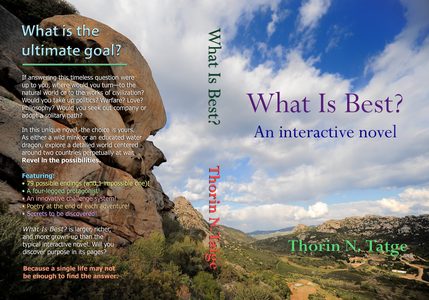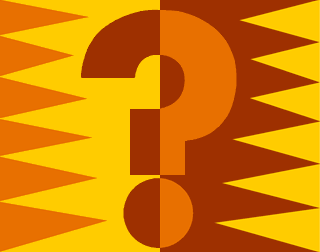What Is Best?
is a novel I wrote between November 2008 and May 2009. It
began as my sixth National Novel Writing Month project; I
wrote the first 70,000 words during November. Of all the
novels I've begun, it's the first that I've finished to my
own satisfaction. I originally sold it through
CreateSpace, a nifty print-on-demand company, but it was
acquiredby Amazon.com and eventually merged with their own
digital publishing platform, KPD, which makes me
sad. So the CreateSpace store is gone, but you can
still buy the book here.
It's only available in hardcover, which is silly, given
that it's an interactive novel and really deserves a
hyperlinked version. But I've put off figuring out
how to do that well. At some point I plan to, and
then I'll put out a digital version for $4 in various
formats.
So what makes this novel unique? Well for starters, as I mentioned, it's an interactive, non-linear work. Instead of reading it from beginning to end, you get directed from one section to another depending on the choices you make. This makes it possible to have a wide variety of reading experiences and to reach as many as eighty different endings. It means that the whole book can comfortably be read in a sitting, but also that you can 'read' it over and over without becoming bored. It means that you can indulge in a rare luxury for fiction and explore what would have happened if the main character had done something different. It's also written in the second person viewpoint and present tense, as is traditional for interactive novels.
 |
|
The
front cover is visible at the CreateSpace
e-store, but here's what the full
wraparound cover looks like! Click for a larger
image!
|
All this makes What Is Best? unusual, but not unique, as there are numerous books and series out there with such a structure. I enjoyed many of them while growing up, such as the Choose Your Own Adventure, Endless Quest, Zork, and Fighting Fantasy series. Because of this influence, I've always wanted to write an interactive book of my own. My first such effort was a 16-page book made from folded paper I wrote and illustrated in second grade. It was a venture into a treasure-laden dungeon guarded by a dragon. Knowing even then that mere non-linearity wasn't enough, I assigned the reader points for each treasure discovered.
When I decided to finally go for it in November, I knew I'd be throwing in all the bonus features I could manage. As a result, What Is Best? has a nifty challenge system, a handful of hidden secrets, and an engrossing introductory sequence that I'm rather proud of. It doesn't have interior illustrations, which are something I may commission eventually for a second edition, but I did write a poem for every one of the eighty endings, since I feel like it's good to have some food for thought and a chance to unwind when you hit "The End".
Moreover, the book is large for its kind. 384 pages, 251 sections, and, by my best estimate, about a thousand different routes you can take every time you read. The structure isn't simple. It's not written for children, although I don't doubt a bright child would enjoy it. The language is at a typical adult level. The story can take you to a lot of different places in terms of both setting and content. There are a lot of characters and a lot of things to get mixed up in.
 |
|
Click here to
read an excerpt from the book!
|
The final factor making this novel unique is the fact that it's got an animal protagonist. You 'play' as either a mink--the cute little semi-aquatic critter prized for its velvety fur--or as a water dragon--a picturesque, curious, river-dwelling lizard. In each case, you're a fictional species of a real genus. You're small, four-legged, and exactly like the animal in nature except that you can talk and reason. So can all the terrestrial vertebrates in the world of this book, a trope common in my work.
That, though, isn't really important. The important distinction here isn't between human and animal: it's between wild and civilized. As the mink, you live wild and get to explore civilization if you want...or you can live your whole life without ever setting foot indoors or even taking a name. As the water dragon, you grow up civilized and educated in a wealthy home. In either case, it's humans who run the world, which means that anything you accomplish is likely to be against the odds.
If all this intrigues you, I urge you to pick up the book! As with this website in general, I hope to add more updates in time.
